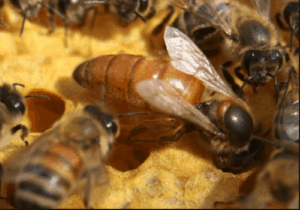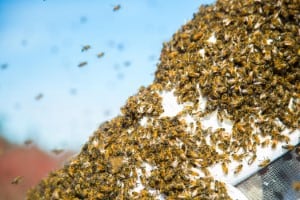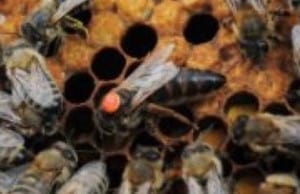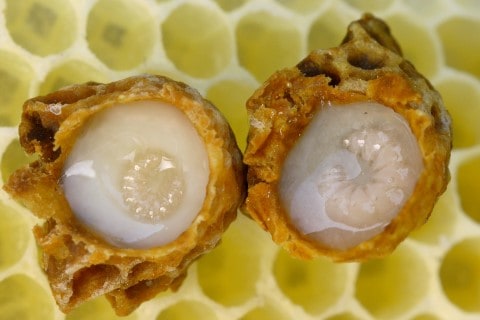The queen bee is probably the most peculiar member of a honey bee colony and certainly the most important one. The colony must always have a healthy queen in order to survive. For this reason, sometimes a new queen needs to be introduced. When this is the case, the new queen can either be accepted or rejected by the worker bees.

But what happens when bees reject the queen? If she is rejected, the queen will die. Worker bees tend to reject the queens they are not familiar with, especially if the workers are not genetically related to the new queen. In these cases, the workers will recognize the bee as an invader and try to defend the hive. They do this by forming a ball around the queen and stinging her until she is dead. In some rare cases, the queen might survive the balling as the workers get used to her and decide to accept her.
Now, to get a deeper understanding of the reasons why bees might reject a new queen, we need to understand first the natural process of queen succession and honey bee colonies. After this, we’ll consider the various situations when a new queen needs to be introduced into the colony by the beekeeper and finally, will give you a detailed answer to the question of honey bee rejection. If this sounds interesting, keep reading!
If you are interested in learning more about how to cultivate your garden to be friendly to bees and other insects or the basics of becoming a beekeeper, checkout our online course recommendations here.
Table of Contents
How Does A Colony Get A New Queen?
As you probably know, in each colony there are thousands of worker bees but only one queen and in fact, a colony can’t function properly without a queen. The queen is the only bee capable of laying fertilized eggs and having no queen spells doom for the rest of the colony. Of course, queens are not immortal, and bees have a natural way of growing a new queen. There are a couple of natural ways for honey bee colonies to get a new queen.
1. Supersedure
Supersedure is the most common way of how bee colonies get a new queen. It happens in the wild all the time, and it can also happen in beehives kept by beekeepers if you let things run their natural course. When a queen bee lays fertilized eggs, these can become either worker bees or queen bees. What makes the difference is the way the larvae are fed by the worker bees taking care of the brood. Namely, larvae destined to become queen bees are fed exclusively with large amounts of royal jelly, which causes them to develop their reproductive system fully and grow into queen bees.
The worker bees can easily notice when the old queen is dead or gone. This is because the queen always leaves a trail of pheromones that worker bees can sense, and the absence of these pheromones signals that the queen is missing. Once this happens, worker bees start preparing queen cells and growing larvae that will become queens. This sometimes happens even before the old queen dies, as worker bees can sometimes notice she is becoming weak. If all goes well, usually a couple of new queens will emerge. They will actually fight each other until only one remains, because colonies with multiple queens just don’t work.
2. Swarming

Swarming is the main way how bee colonies multiply in the wild. When swarming happens, the queen bee flies away from the hive with approximately half of the worker bees in the colony. The swarm will then find a new place to build a hive. However, before flying off, the queen also lays enough eggs in the old hive. When the queen is gone, the worker bees can grow a new queen from the eggs remaining, in the same way as with supersedure.
How Do Hives Become Queenless?
So far, we have talked about the natural ways of colonies getting a new queen. Basically, there are three things that usually happen.
- The old queen might be weak, start under-performing, and slowly die.
- She might fly away with a swarm to create a new colony naturally.
- The queen simply disappears suddenly, being killed or getting lost in some other way.
However, in all of these cases, things can actually go wrong, and when this happens the hive can become queenless.
Namely, while worker bees can actually sometimes lay eggs, they can only lay unfertilized eggs that would grow to become drones. This is a problem, as drones don’t actually do anything to keep the hive alive. This is why the fertilized eggs created by the queen are necessary for the colony to survive. Therefore, when the queen disappears for whatever reason, the workers have only a short window of time to grow a new queen. So what happens if they fail? In the wild, the colony would simply slowly die off and disappear. Luckily, the beekeeper can step in and change all of this by introducing a new queen. If the queen does not get rejected, that is.
Requeening

What is re-queening? Well, it is just what it sounds like – re-queening refers to cases where the beekeeper introduces a new queen into the colony. Sometimes this involves also removing the old queen, but this need not always be the case. Namely, there are a lot of beekeepers that choose to re-queen every fall just to keep the colonies more productive. There is a simple reason for this – as the queen ages, she starts laying fewer eggs and her pheromone production decreases which results in a colony that is less productive overall. However, this is not necessarily the right choice. If things are left to run their natural course, the colony will usually produce a new queen on its own. Another common reason for re-queening is when a colony is being split in two, so the beekeeper decides to introduce a new queen instead of letting the colony raise their own.
In both of these cases, and in many others, it is possible but not necessary to requeen and it’s a matter of best judgment of the beekeeper. However, when you are dealing with a queenless hive, introducing a new queen is often the only way to go. Especially in cases where there is no brood or eggs left behind by the old queen, it becomes absolutely essential to requeen. Otherwise, the worker bees will start laying unfertilized eggs which become drones, and this will cause the colony to slowly die off. Now, when introducing a new queen, there is always a risk of the queen being rejected. Why does this happen? Let’s see!
Why Do Colonies Sometimes Reject Their Queens?
The Queen Is Unfamiliar To The Workers
The first and by far the most common reason why honey bees reject a new queen is the fact that she is unfamiliar to them. This is because every queen leaves around her a specific pheromone that allows the worker bees to recognize her. In simple terms, a new queen just doesn’t smell right to the worker bees. For the same reason, worker bees will much more easily accept a queen that is coming from a colony that is genetically related to them. This is why the best-case scenario is introducing a queen that comes from a colony closely related to the queenless one, or at least from the same geographic area. Alternatively, a new queen can be purchased. In this case, there is a much higher risk of rejection, but there are ways to prevent this.
A Special Case: Diploid Males
There is another rather peculiar case where worker bees decide to reject, or rather kill, the queen. This does not happen with honey bees, though, but with a species of stingless bees called Scaptotrigona depilis. A new study, conducted in Brazil, has shown that members of this species decide to eliminate the queen in cases where she starts producing useless, sterile males (drones), also called diploid males (the normal males are haploid). This happens in rare cases where the queen mates with a drone with a genetic structure extremely similar to her own. Research has shown that in cases where this happens, the workers will spontaneously kill the queen in order to keep the colony productive.

Diploid males can appear in honey bees too, but in worker bees that attend to the brood can smell the diploid male while it’s still in the early stages of development. If this happens, they will kill the young drone, thus solving the problem before it arises.
What Happens When Bees Reject The Queen?
So, once you introduce a new queen, how does one know that she is being rejected? Actually, it is not very hard to tell. If the worker bees decide to reject the queen this is because they see her as an enemy and a threat. For this reason, their behavior will be extremely aggressive, the final result being simply the death of the queen.
But how do honey bees kill the queen? It’s actually a very peculiar process called “queen balling”. Queen balling is just what it sounds like – when worker bees notice the presence of a new queen, they will form a tight ball around her body. Balling does not necessarily result in the death of the queen. Sometimes the worker bees will stinger her, sometimes they will just place their abdomens in a stinging position. They might also use their mouths to pull the queen by her antennae and her wings. In some cases, the workers decide to let the queen live, but it is much more common for her to die in the end. Interestingly, we still don’t completely understand the reasons for different patterns of behavior when worker bees form a ball around the queen.
How To Introduce A New Queen And Avoid Rejection
In order to lower the chances of the queen being killed, beekeepers usually introduce the queen in a small cage. This way, the worker bees can smell the queen and get used to her presence, while the cage protects her from being killed. One option with the cages is to get a cage with a candy plug. The idea is that by the time the workers eat the plug (which should take 2-5) days, they will get used to the queen. Otherwise, the queen needs to be released manually.
Related Questions
What happens when a queen bee dies?
When a queen bee dies, the worker bees need to grow a new queen (at least in the natural course of events). If the old queen has left behind some eggs, the worker bees can easily grow a new queen by feeding royal jelly to certain larvae.
What are the symptoms of a queenless hive?
One common symptom of a queenless hive is a lack of brood and eggs. Consequently, the worker bees who used to tend to the brood will start foraging, so an increase in honey and pollen production can also be noticed (this is only for the short-term, though). Moreover, queenlessness often results in a change in temperament of the workers. They might even start laying eggs, but since these eggs are unfertilized they will produce only drones.
Sources
J S Pettis, L C Westcott & M L Winston (1998) Balling behaviour in the honey bee in response to exogenous queen mandibular gland pheromone, Journal of Apicultural Research, 37:2, 125-131, DOI: 10.1080/00218839.1998.11100964
Vollet-Neto, Ayrton, et al. “Diploid male production results in queen death in the stingless bee Scaptotrigona depilis.” Journal of chemical ecology 43.4 (2017): 403-410.
Mangum, Wyatt A. “Queen introduction: a review of the basics and a description of hostile worker behavior towards the new queen bee.” American bee journal (USA) (1997).
